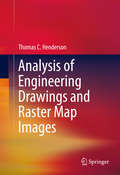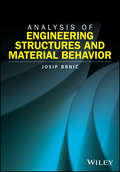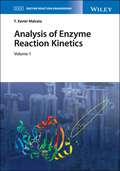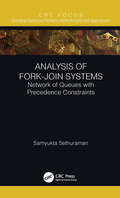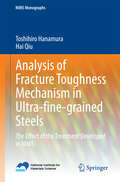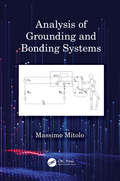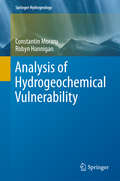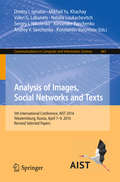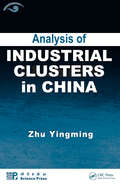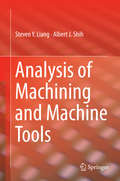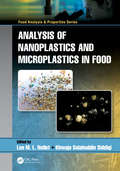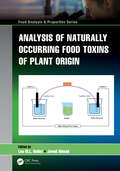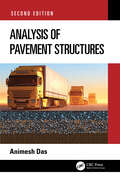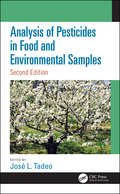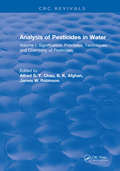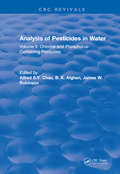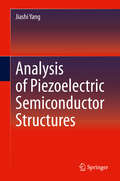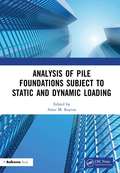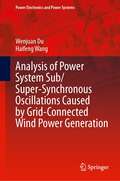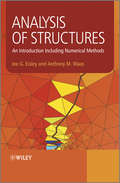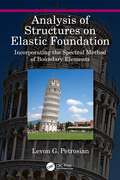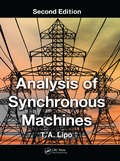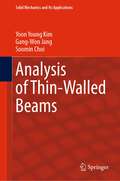- Table View
- List View
Analysis of Engineering Drawings and Raster Map Images
by Thomas HendersonThis book covers up-to-date methods and algorithms for the automated analysis of engineering drawings and digital cartographic maps. The Non-Deterministic Agent System (NDAS) offers a parallel computational approach to such image analysis. The book describes techniques suitable for persistent and explicit knowledge representation for engineering drawings and digital maps. It also highlights more specific techniques, e.g., applying robot navigation and mapping methods to this problem. Also included are more detailed accounts of the use of unsupervised segmentation algorithms to map images. Finally, all these threads are woven together in two related systems: NDAS and AMAM (Automatic Map Analysis Module).
Analysis of Engineering Structures and Material Behavior
by Josip BrnicAnalysis of Engineering Structures and Material Behavior Professor Josip Brnic, University of Rijeka, Croatia Theoretical and experimental study of the mechanical behavior of structures under load Analysis of Engineering Structures and Material Behavior is a textbook covering introductory and advanced topics in structural analysis. It begins with an introduction to the topic, before covering fundamental concepts of stress, strain and information about mechanical testing of materials. Material behaviors, yield criteria and loads imposed on the engineering elements are also discussed. The book then moves on to cover more advanced areas including relationships between stress and strain, rheological models, creep of metallic materials and fracture mechanics. Finally, the finite element method and its applications are considered. Key features: Covers introductory and advanced topics in structural analysis, including load, stress, strain, creep, fatigue and finite element analysis of structural elements. Includes examples and considers mathematical formulations. A pedagogical approach to the topic. Analysis of Engineering Structures and Material Behavior is suitable as a textbook for structural analysis and mechanics courses in structural, civil and mechanical engineering, as well as a valuable guide for practicing engineers.
Analysis of Enzyme Reaction Kinetics (Enzyme Reaction Engineering)
by F. Xavier MalcataComprehensively introduces readers to modelling of rate of enzymatic reactions, including effects of physicochemical parameters Analysis of Enzyme Reaction Kinetics is the second set in a unique eleven-volume collection on Enzyme Reactor Engineering. It describes rate expressions pertaining to enzymatic reactions, including modulation by physicochemical factors, as well as tools for prediction and control of how fast substrates are transformed to products. Volume 1 details rate expressions mathematically derived from mechanistic postulates, and is complemented by appropriate statistical approaches to fit them to experimental data. Volume 2 discusses the effects of physical and chemical parameters upon the rates of both enzyme-catalyzed and enzyme-deactivation reactions. Starting with basic concepts and historical perspectives, the first volume introduces readers to the mathematics of rate expressions. It then goes on to cover kinetic features and the many forms of Michaelis & Menten’s-type rate expressions (single and multiple enzymes, autocatalysis, single and multiple substrates, multiphasic systems, etc.), and concludes with the statistical analysis of rate expressions – including the assessment of data, fitting of models to data, and generation of data themselves. The second volume introduces readers to physicochemical modulation of reaction rate – starting with basic concepts, and looking specifically at temperature-, mechanical force-, pH- and compound-driven effects: both unimodal and bimodal deactivation are considered. Analysis of Enzyme Reaction Kinetics 2V Set is a comprehensive work for those studying or working with enzyme reactions, or practitioners involved in the control of reactors. SERIES INFORMATION Enzyme Reactor Engineering is organized into four major sets: Enzyme Reaction Kinetics and Reactor Performance; Analysis of Enzyme Reaction Kinetics; Analysis of Enzyme Reactor Performance; and Mathematics for Enzyme Reaction Kinetics and Reaction Performance.
Analysis of Food Spices: Identification and Authentication (ISSN)
by Javed Ahmad Javed Ahamad Nollet, Leo M.L.Spices are obtained from natural sources, especially from plants, and are used in cooking food in whole or grounded forms mainly for imparting flavor, aroma, and piquancy. Besides their role in improving food quality, spices also have health benefits that are anticancer, antidiabetic, antimicrobial, antioxidant, hypolipidemic, analgesic, immunostimulant, and more.Spices are generally marketed in powder form, and their supply chain is very long and complicated, which is why they are particularly susceptible to adulteration at many points. The spice supply chain is considered to be moderately vulnerable and has an ineffective quality detection system in its final product, which is the main risk factor. There are many types of fraud nowadays related to spices such as adulteration, falsification, substitution, and inaccurate labeling.Analysis of Food Spices: Identification and Authentication provides an overview of spices of different categories, such as terpenes and terpenoids, oleoresins, alkaloids, and polyphenolics and flavonoids, as well as qualitative and quantitative guidelines for ensuring their quality and safety using modern analytical tools and techniques. The first section of the book discusses the overview, sources, and health benefits of important categories of spices such as terpenes and terpenoids (cardamom, cinnamon, clove, coriander, cumin, fennel), oleoresins (capsicum, ginger, nutmeg), alkaloids (black pepper, fenugreek), and polyphenolics and flavonoids (basil, turmeric, olive, saffron). In the second section, qualitative diagnostic features of spices are covered. In the third section, the roles of quantitative analytical techniques, such as HPLC, LC-MS, HPTLC, GC, and GC-MS, capillary electrophoresis (CE), and other recent techniques in the analysis of food spices, are also discussed. Each chapter concludes with a general reference section, which is a bibliographic guide to more advanced texts.Key Features Provides a detailed overview of different food spices of plant origin, and discusses their health benefits and uses of different analytical techniques in its quality control Explains how qualitative diagnostic features of food spices are utilized as quality control tools Describes applicability of analytical techniques like HPLC, LC-MS, GC-MS, HPTLC, and CE for quality control of food spices Emphasizes use of recent techniques such as proteomics, biosensors, and more in the analysis/quality control of food spices This book will provide important guidelines for controlling quality, safety, and efficacy issues related to food spices.
Analysis of Food Toxins and Toxicants
by Richard J. Lewis Yiu-Chung WongAnalysis of Food Toxins and Toxicants consists of five sections, providing up-to-date descriptions of the analytical approaches used to detect a range of food toxins. Part I reviews the recent developments in analytical technology including sample pre-treatment and food additives. Part II covers the novel analysis of microbial and plant toxins including plant pyrrolizidine alkaloids. Part III focuses on marine toxins in fish and shellfish. Part IV discusses biogenic amines and common food toxicants, such as pesticides and heavy metals. Part V summarizes quality assurance and the recent developments in regulatory limits for toxins, toxicants and allergens, including discussions on laboratory accreditation and reference materials.
Analysis of Fork-Join Systems: Network of Queues with Precedence Constraints (Emerging Operations Research Methodologies and Applications)
by Samyukta SethuramanWith the boom of big data and machine learning and the subsequent need for parallel processing technologies, fork-join queues are more relevant now than ever before. In this book, new estimates of the average response time in fork-join queues are proposed, which form the basis for new research opportunities. Analysis of Fork-Join Systems: Network of Queues with Precedence Constraints explores numerical approaches to estimate the average response time of fork-join queueing networks and offers never before published simple expressions for the mean response time as conjectures. Extensive experiments are included to demonstrate the remarkable accuracy of the conjectures and algorithms used in the estimation of the average response time. Graduate students, professors, and researchers in the fields of operations research, management science, industrial engineering, computer science, and electrical engineering will find this book very useful. Students, as well as researchers in both academia and industry, will also find this book of great help when looking for results related to fork-join queues
Analysis of Fracture Toughness Mechanism in Ultra-fine-grained Steels: The Effect of the Treatment Developed in NIMS (NIMS Monographs)
by Toshihiro Hanamura Hai QiuIn this book, advanced steel technologies mainly developed at the National Institute for Materials Science (NIMS), Japan, for structure control, mechanical properties, and the related mechanisms are introduced and discussed. NIMS has long worked on developing advanced steel techniques, namely, producing advanced steels by using only simple alloying elements such as carbon, manganese, and silicon, and also by utilizing steel scrap. The hope is that this approach will lead to a technology of a so-called steel-to-steel recycling process, with the ultimate goal of a recycling process such as an automotive-steel-to-automotive-steel recycling process to take the place of the current cascade-type recycling system. The main idea is to utilize ultra-grain refining structures and hetero structures as well as martensite structures. In particular, the focus of this book is on tensile strength and toughness of advanced steels from both the fundamental and engineering points of view. Fundamentally, a unique approach to analysis is taken, based on fracture surface energy as effective grain size is employed to better understand the mechanism of property improvement. From the engineering point of view, in fracture toughness such factors as crack tip opening displacement (CTOD) of advanced steels are evaluated in comparison with those of conventional steels.
Analysis of Grounding and Bonding Systems
by Massimo MitoloLearn the theory behind grounding systems and bonding equipotential connections from a worldwide expert. Through mathematical analysis, comprehensive explanations, and detailed figures, Analysis of Grounding and Bonding Systems explains the theory and the reasons behind basic ground-electrodes (i.e., the sphere, the ground rod, and the horizontal ground wire), and more complex grounding systems (i.e., ground-grids), buried in uniform and non-uniform soils. Through calculations and explanatory diagrams, this comprehensive guide provides code-complying solutions for the safety against electric shock provided by equipotential bonding connections between exposed-conductive-parts, such as equipment enclosures, and metalwork. Details on the calculation of step and touch voltages in different types of system grounding (i.e., TT, TN, and IT) are provided, also with the aid of solved problems. Readers will learn how to minimize hazardous interactions between grounding systems, cathodically protected pipelines, and heat networks. The analysis of the effectiveness of bonding systems against electric shock in the case of contact with electric vehicles during charge in the event of ground-faults, which is an upcoming issue challenging our safety, is included.
Analysis of Hydrogeochemical Vulnerability (Springer Hydrogeology)
by Robyn Hannigan Constantin MoraruThis monograph instructs the reader on how to analyze the hydrogeochemical vulnerability. It introduces notions of geochemical signals, points of migration of pollutants in the unsaturated zone, and new hydrogeochemical classifications. Three test sites in the USA, Germany, and Moldova are described as case studies accompanied by illustrative data. The authors presuppose for future readers only the background mathematics and elementary knowledge of hydrogeology. The presented methodology is both for local and regional assessments. It is simple, does not need implication of high qualification specialists and can be applied to test the groundwater quality. The book is useful for undergraduate, graduate, master, and PhD students as well as water quality specialists, ecologists and geology professionals.
Analysis of Images, Social Networks and Texts: 5th International Conference, AIST 2016, Yekaterinburg, Russia, April 7-9, 2016, Revised Selected Papers (Communications in Computer and Information Science #661)
by Andrey V. Savchenko Dmitry I. Ignatov Mikhail Yu. Khachay Alexander Panchenko Valeri G. Labunets Natalia Loukachevitch Sergey I. Nikolenko Konstantin VorontsovThis book constitutes the proceedings of the 5th International Conference on Analysis of Images, Social Networks and Texts, AIST 2016, held in Yekaterinburg, Russia, in April 2016. The 23 full papers, 7 short papers, and 3 industrial papers were carefully reviewed and selected from 142 submissions. The papers are organized in topical sections on machine learning and data analysis; social networks; natural language processing; analysis of images and video.
Analysis of Industrial Clusters in China
by Zhu YingmingTaking a close look at the national economic system of China, this book defines industrial clusters, then summarizes their measurement indices and identifies their methods. The author identifies 11 industrial clusters and analyses their structural relationships. He studies the relationships between structures and characters of industrial clusters u
Analysis of Machining and Machine Tools
by Steven Y. Liang Albert J. ShihThis book provides readers with the fundamental, analytical, and quantitative knowledge of machining process planning and optimization based on advanced and practical understanding of machinery, mechanics, accuracy, dynamics, monitoring techniques, and control strategies that they need to understanding machining and machine tools. It is written for first-year graduate students in mechanical engineering, and is also appropriate for use as a reference book by practicing engineers. It covers topics such as single and multiple point cutting processes; grinding processes; machine tool components, accuracy, and metrology; shear stress in cutting, cutting temperature and thermal analysis, and machine tool chatter. The second section of the book is devoted to "Non-Traditional Machining," where readers can find chapters on electrical discharge machining, electrochemical machining, laser and electron beam machining, and biomedical machining. Examples of realistic problems that engineers are likely to face in the field are included, along with solutions and explanations that foster a didactic learning experience.
Analysis of Nanoplastics and Microplastics in Food (Food Analysis & Properties)
by Leo M. L. Nollet and Khwaja Salahuddin SiddiqiThe world’s ever increasing use of plastics has created large areas of floating plastic waste in the oceans—so-called plastic soup. This floating plastic debris is gradually fragmenting into smaller particles which eventually become microplastics, and even nanoplastics. Analysis of Nanoplastics and Microplastics in Food compiles data on nanoplastics and microplastics in food. To date, there is some data on this, particularly for the marine environment. Fish show high concentrations, but because microplastics are mostly present in the stomach and intestines, they are usually removed and consumers are not exposed. But in crustaceans and bivalve molluscs like oysters and mussels, the digestive tract is consumed, so there is some exposure. Microplastics have also been reported in honey, beer, and table salt. Key Features: Discusses sampling and analysis of nano- and microplastics Details the impacts of plastic residues in diverse compartments of the environment Includes a discussion of microplastics in freshwater Discusses interactions of microplastics and POPs This book brings to light the reality—and dangers—of microplastics in food. Pollutants like polychlorinated biphenyls (PCBs) and polycyclic aromatic hydrocarbons (PAHs) can accumulate in microplastics. Some studies suggest that, after consuming microplastics in food, these substances may transfer into tissues. So, it is important to estimate the average intake. Since engineered nanoparticles (from different types of nanomaterials) can enter human cells, this reality can pose consequences for human health. Also available in the Food Analysis and Properties Series: Mass Spectrometry Imaging in Food Analysis, edited by Leo M. L. Nollet (ISBN: 978-1-138-37069-2) Proteomics for Food Authentication, edited by Leo M. L. Nollet and Semih Ӧtleş (ISBN: 978-0-367-20505-8) Food Aroma Evolution: During Food Processing, Cooking, and Aging, edited by Matteo Bordiga and Leo M. L. Nollet (ISBN: 978-1-138-33824-1) For a complete list of books in this series, please visit our website at: www.crcpress.com/Food-Analysis--Properties/book-series/CRCFOODANPRO
Analysis of Naturally Occurring Food Toxins of Plant Origin (Food Analysis & Properties)
by Javed Ahmad Nollet, Leo M. L.Natural toxins are toxic compounds that are naturally produced by living organisms. These toxins are not harmful to the organisms themselves, but they may be toxic to other creatures, including humans, when eaten. These chemical compounds have diverse structures and differ in biological function and toxicity. Some toxins are produced by plants as a natural defense mechanism against predators, insects, or microorganisms, or as a consequence of infestation with microorganisms, such as mold, in response to climate stress (such as drought or extreme humidity). Well-known groups of natural toxins of plant origin are: cyanogenic glycosides, pyrrolizidine alkaloids, furocoumarins, lectins, and glycoalkaloids. These plant-origin natural toxins can cause a variety of adverse health effects and pose a serious health threat to both humans and livestock. Analysis of Naturally Occurring Food Toxins of Plant Origin is divided into three sections that provide a detailed overview of different classes of food toxins that are naturally found in plants, including various analytical techniques used for their structural characterization, identification, detection, and quantification. This book provides in-depth information and comprehensive discussion over quantitative and qualitative analysis of natural toxins in plant-based foods. Key Features: • Provides a detailed overview of different classes of natural toxins found in plants. • Explains how IR, NMR, and mass spectrometry are utilized in characterization and identification. • Describes applicability of HPLC, LC-MS, GC-MS, and HPTLC techniques for detection and quantification. • Discusses progress in the field related to capillary electrophoresis, ELISA, and biosensors for quantitative application of these techniques. Also available in the Food Analysis and Properties Series: Nutriomics: Well-being through Nutrition, edited by Devarajan Thangadurai,Saher Islam,Leo M.L. Nollet, Juliana Bunmi Adetunji (ISBN: 9780367695415) Bioactive Peptides from Food: Sources, Analysis, and Functions, edited by Leo M.L. Nollet and Semih Ötleş (ISBN: 9780367608538) Mass Spectrometry in Food Analysis, edited by Leo M.L. Nollet, and Robert Winkler (ISBN: 9780367548797) For a complete list of books in this series, please visit our website at:www.crcpress.com/Food-Analysis--Properties/book-series/CRCFOODANPRO
Analysis of Pavement Structures
by Animesh DasAnalysis of Pavement Structures brings together current research and existing knowledge on the analysis and design of pavements and introduces load and thermal stress analyses of asphalt and concrete pavement structures in a simple and step-by-step manner. For the second edition of this book, a new chapter on numerical implementation (using FEM) of pavement analysis is added along with topics such as mechanical modeling of granular materials, applications of convolution theorems in visco-elasticity, visco-elastic Poisson’s ratio, concepts of fracture mechanics in relation to fatigue of asphalt mix, solution of semi-infinite and so forth. New solved examples and schematic diagrams are also added. Features: Presents a simple, step-by-step approach for pavement analysis including systematic compilation of research work in the area Discusses further elaborations in terms of extended analytical formulations on some selected topics Includes new chapter on finite element analysis for pavement structures Contains more solved examples to understand the concepts better Explores primary application of pavement analysis in pavement thickness design This book is aimed at graduate students, structural mechanics researchers, and senior undergraduate students in civil/pavement/highway/transport engineering.
Analysis of Pesticides in Food and Environmental Samples, Second Edition
by Jose L. TadeoThis book provides a critical overview of analytical methods used for the determination of pesticide residues and other contaminants in food and environmental samples by modern instrumental analysis. It contains up-to-date material including recent trends in sample preparation, general methods used for pesticide analysis and quality assurance aspects, and chromatographic and immunoassay methods. The rest of the book describes particular analytical methods used for the determination of pesticides in food and soil, water and air. In addition, the levels of these chemicals found in food, their regulatory aspects and the monitoring of pesticides in the environment are described.
Analysis of Pesticides in Water: Volume I: Significance, Principles, Techniques, and Chemistry of Pesticides
by Alfred S.Y. ChauThis book, collected by Mr. Chau and Dr. Afghan, is devoted to the broad and important topic of pesticides. It examines important facets such as the significance of the problem, the chemistry of pesticides, and principles and techniques. It will provide excellent reference material for producers, users and testing agencies.
Analysis of Pesticides in Water: Volume II: Chlorine-and Phosphorus- Containing Pesticides
by Alfred S.Y. ChauThis book, collected by Mr. Chau and Dr. Afghan, is devoted to the broad and important topic of pesticides. It examines important facets such as the significance of the problem, the chemistry of pesticides, and principles and techniques. It will provide excellent reference material for producers, users and testing agencies.
Analysis of Piezoelectric Semiconductor Structures
by Jiashi YangThis book presents the mechanics of piezoelectric semiconductor structures where the main electromechanical coupling of interest is the interaction between mechanical fields and semiconduction. This volume stands as the first full book treatment of this multi-physical subject from the mechanics angle. The analysis of piezoelectric semiconductor structures and devices is an emerging and rapidly growing interdisciplinary area involving materials, electronics, and solid mechanics. It has direct applications in the new area of piezotronics and piezo-phototronics. The book is theoretical, beginning with a phenomenological framework and progressing to include solutions to problems fundamental to the theory and application. Dr. Yang illustrates how in piezoelectric semiconductors, mechanical fields interact with semiconduction through the piezoelectrically produced electric fields by mechanical loads. This provides the foundation of piezotronic and piezo-phototronic devices in which semiconduction is induced, affected, manipulated, or controlled by mechanical fields. Also discussing composite structures of piezoelectric dielectrics and nonpiezoelectric semiconductors as well as thermal effects, the book is an ideal basic reference on the topic for researchers.
Analysis of Pile Foundations Subject to Static and Dynamic Loading
by Amir M. KayniaThis book presents computational tools and design principles for piles used in a wide range of applications and for different loading conditions. The chapters provide a mixture of basic engineering solutions and latest research findings in a balanced manner. The chapters are written by top experts in the field. The materials are presented in a unified manner based on both simplified and rigorous numerical methods. The first four chapters present the basic elements and steps in analysis of piles under static and cyclic loading together with clear references to the appropriate design regulations in Eurocode 7 when relevant. The analysis techniques cover conventional code-based methods, solutions based on pile-soil interaction springs, and advanced 3D finite element methods. The applications range from conventional piles to large circular steel piles used as anchors or monopiles in offshore applications. Chapters 5 to 10 are devoted to dynamic and earthquake analyses and design. These chapters cover a range of solutions from dynamic pile-soil springs to elasto-dynamic solutions of large pile groups. Both linear and nonlinear soil behaviours are considered along with response due to dynamic loads and earthquake shaking including possible liquefaction. The book is unique in its unified treatment of the solutions used for static and dynamic analysis of piles with practical examples of application. The book is considered a valuable tool for practicing engineers, graduate students and researchers.
Analysis of Power System Sub/Super-Synchronous Oscillations Caused by Grid-Connected Wind Power Generation (Power Electronics and Power Systems)
by Haifeng Wang Wenjuan DuThis book provides a systematic introduction to power system sub/super-synchronous oscillations caused by grid-connected wind power generation. The authors look at why oscillations occur and present methods for examining the risk of oscillations. Coverage includes state-space model based analysis and impedance model based analysis, which are the two main methods for examining the power system sub/super-synchronous oscillations. In addition, new methods for examining oscillations in wind farms are proposed. Analysis of Power System Sub/Super-Synchronous Oscillations Caused by Grid-connected Wind Power Generation provides researchers and students with a single-volume introduction to the subject and will be a valuable professional reference for practicing engineers looking for solutions to oscillation problems.
Analysis of Structures
by Antony M. Waas Joe G. EisleyAnalysis of Structures offers an original way of introducing engineering students to the subject of stress and deformation analysis of solid objects, and helps them become more familiar with how numerical methods such as the finite element method are used in industry.Eisley and Waas secure for the reader a thorough understanding of the basic numerical skills and insight into interpreting the results these methods can generate.Throughout the text, they include analytical development alongside the computational equivalent, providing the student with the understanding that is necessary to interpret and use the solutions that are obtained using software based on the finite element method. They then extend these methods to the analysis of solid and structural components that are used in modern aerospace, mechanical and civil engineering applications.Analysis of Structures is accompanied by a book companion website www.wiley.com/go/waas housing exercises and examples that use modern software which generates color contour plots of deformation and internal stress.It offers invaluable guidance and understanding to senior level and graduate students studying courses in stress and deformation analysis as part of aerospace, mechanical and civil engineering degrees as well as to practicing engineers who want to re-train or re-engineer their set of analysis tools for contemporary stress and deformation analysis of solids and structures. Provides a fresh, practical perspective to the teaching of structural analysis using numerical methods for obtaining answers to real engineering applicationsProposes a new way of introducing students to the subject of stress and deformation analysis of solid objects that are used in a wide variety of contemporary engineering applicationsCasts axial, torsional and bending deformations of thin walled objects in a framework that is closely amenable to the methods by which modern stress analysis software operates.
Analysis of Structures on Elastic Foundation: Incorporating the Spectral Method of Boundary Elements
by Levon G. PetrosianThis book is devoted to the static and dynamic analysis of structures on elastic foundation. Through comprehensive analysis, the book shows analytical and mechanical relationships among classic and modern methods of solving boundary value problems. The book provides a wide spectrum of applications of modern techniques and methods of calculation of static and dynamic problems of engineering design. It pursues both methodological and practical purposes, and the accounting of all methods is accompanied by solutions of the specific problems, which are not merely illustrative in nature but may represent an independent interest in the study of various technical issues. Two special features of the book are the extensive use of the generalized functions for describing the impacts on structures and the substantiations of the methods of the apparatus of the generalized functions. The book illustrates modern methods for solving boundary-value problems of structural mechanics and soil mechanics based on the application of boundary equations. The book presents the philosophy of boundary equations and boundary element methods. A number of examples of solving different problems of static and dynamic calculation of structures on an elastic foundation are given according to the methods presented in the book. Introduces a general approach to the method of integral transforms based on the spectral theory of the linear differential operators. The Spectral Method of Boundary Element (SMBE) is developed based on using integral transforms with an orthogonal kernel in the extended domain. Presents a new, versatile foundation model with a number of advantages over the ground-based models currently used in practical calculations. Provides new transforms which will aid in solving various problems relevant to bars, beams, plates, and shells in particular for the structures on elastic foundation. Examines the methods of solving boundary-value problems typical for structural mechanics and related fields.
Analysis of Synchronous Machines
by T.A. LipoAnalysis of Synchronous Machines, Second Edition is a thoroughly modern treatment of an old subject. Courses generally teach about synchronous machines by introducing the steady-state per phase equivalent circuit without a clear, thorough presentation of the source of this circuit representation, which is a crucial aspect. Taking a different approach, this book provides a deeper understanding of complex electromechanical drives. Focusing on the terminal rather than on the internal characteristics of machines, the book begins with the general concept of winding functions, describing the placement of any practical winding in the slots of the machine. This representation enables readers to clearly understand the calculation of all relevant self- and mutual inductances of the machine. It also helps them to more easily conceptualize the machine in a rotating system of coordinates, at which point they can clearly understand the origin of this important representation of the machine. Provides numerical examples Addresses Park’s equations starting from winding functions Describes operation of a synchronous machine as an LCI motor drive Presents synchronous machine transient simulation, as well as voltage regulation Applying his experience from more than 30 years of teaching the subject at the University of Wisconsin, author T.A. Lipo presents the solution of the circuit both in classical form using phasor representation and also by introducing an approach that applies MathCAD®, which greatly simplifies and expands the average student’s problem-solving capability. The remainder of the text describes how to deal with various types of transients—such as constant speed transients—as well as unbalanced operation and faults and small signal modeling for transient stability and dynamic stability. Finally, the author addresses large signal modeling using MATLAB®/Simulink®, for complete solution of the non-linear equations of the salient pole synchronous machine. A valuable tool for learning, this updated edition offers thoroughly revised content, adding new detail and better-quality figures.
Analysis of Thin-Walled Beams (Solid Mechanics and Its Applications #257)
by Yoon Young Kim Gang-Won Jang Soomin ChoiThis book presents a comprehensive introduction to an advanced beam theory applicable to thin-walled beams of rectangular and arbitrarily-shaped cross-sections. Furthermore, it describes a unique beam-based approach to handling joint structures consisting of thin-walled beams, compiled here for the first time.This higher-order beam theory (HoBT), developed by the authors over the past two decades, uses more than six degrees of freedom (DOFs) in contrast to the classical theories, which use only six DOFs. The additional degrees of freedom describe sectional deformations such as warping and distortion. This book presents a novel systematic procedure to derive the sectional deformations analytically for rectangular cross-sections and numerically for arbitrarily-shaped cross-sections. This book is a must for structural/mechanical engineers who wish to understand and design structures involving thin-walled beams.
